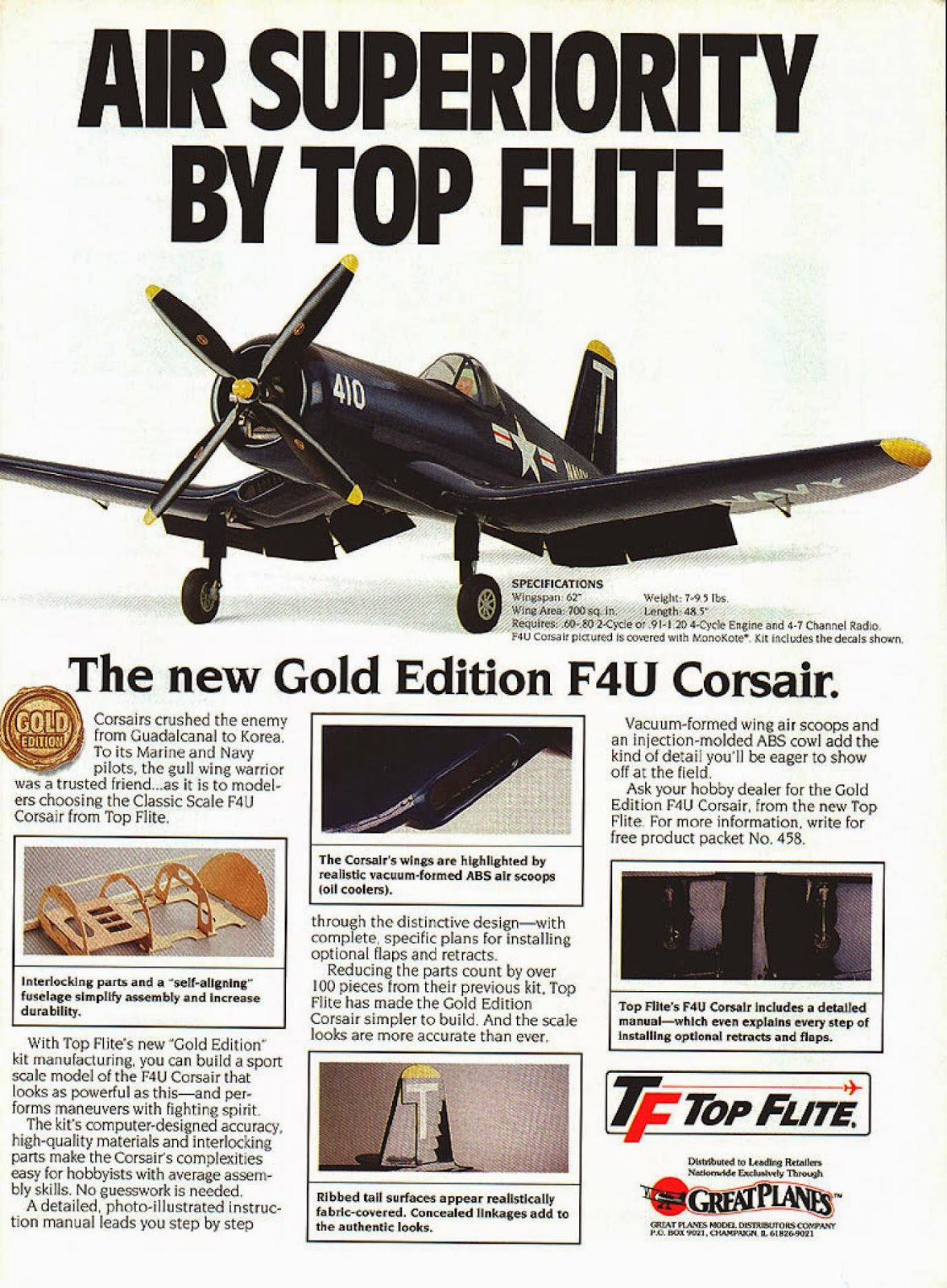Wednesday, 11 June 2014
Top Flite Corsair
Designed by Hal Parenti, the 60 size Corsair was new, back in 1979. The TV show, "Baa Baa Black Sheep" had been on the air for a couple of seasons, so it was a good time to make a scale R/C model. All of their previous kits were USAAF types ( P-39, P-40, P-47, P51 ). Hal would follow the Corsair with models of the Bearcat and Zero.
The markings for this kit were for the famous #86 of Gregory "Pappy" Boyington. He never flew this airplane in combat. The photo session was staged. There is also photo evidence that the name on the side was "Lucybelle" and not "Lulubelle".
Also, the Bureau Number of 18086 is probably wrong and should be 13086, since the former airplane went to the British. The latter was a Goodyear built example.
In any case, I flew the Gold Edition ( David J. Ribbe ), which came out in 1991 or so.
It was a good introduction and prepared me to fly the larger Typhoon model, later on. It was powered originally by an OS 91FS, turning a 16 x 6 Master Airscrew propeller and using 15% Cool Power fuel. This was the best combo for the 12 lbs airplane. Later, I would put a 1.20 in it and then it had a realistic power loading ( 6 lbs per hp ). It was covered with 21st Century fabric ( dark blue ) and white Monokote. The Intermediate Blue was from a spray can of flat primer from Canadian Tire. I had custom built a full cockpit, using photos taken from the Corsair that was at the Canadian Warplane Heritage Museum. I also tried using white glue to make rivets. I remember measuring the plans and comparing to Paul Matt drawings and finding the outline to be quite accurate. The airfoil was even right, albeit a little bit thicker.
The landing gear was problematic. The recommended Robarts had problems with the rotating mechanism, being geared, it would skip a tooth and the wheel would rotate, causing a nose over. We solved that by switching to the Century Jet, but the torque links on those eventually worked loose and wheels would toe in, causing nose overs. That was fixed with JB Weld and so long as I made soft landings, it was ok. The top of the rudder got broken many times!
One day, I tried a 13.8 x 10 4-blade APC prop, which proved too much for the engine and it quit. The dead stick landing was one of those where there was no energy left to flare and it pancaked in a carrier landing style. The wheels, with no give, splayed out and that was the end of that. The airframe was sold to a club member, as I didn't want to buy a third set of retracts for it. But, it flew for a good 10 years or so.
With the 1.20 FS, a 14 x 10 APC worked really well. I recall one flight where I almost lost it. It still had the 90 installed and I went to do a hammerhead with the flaps down. At the top, it started torque rolling and fell into an inverted spin. It would not recover, no matter what I did with the controls. I had to think quickly and finally retracted the flaps, upon which it instantly recovered. Lesson learned! It never liked cross winds and it had a yaw oscillation, as most Corsairs do.
There was another episode where I was attempting to show someone how easy it was to fly, when it suddenly started gyrating all over the place, clearly radio interference. I knew that the onboard glow connector had come off the plug and was striking the cylinder head, causing the problem. As soon as I throttled back, it came under control. The landing was uneventful, but I had to find a better way to crimp the wire onto the plug.
Subscribe to:
Post Comments (Atom)



No comments:
Post a Comment